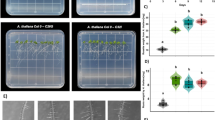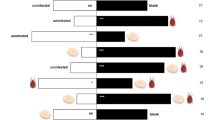Abstract
Glycoalkaloids are a class of secondary compounds (nitrogenous, steroidal glycosides), ubiquitously distributed throughout the Solanaceae. Numerous studies (in planta) have shown that certain glycoalkaloids, e.g., α-tomatine, solanocardenine, and leptine, have a negative impact on performance of the Colorado potato beetle,Leptinotarsa decemlineata (Say). However, the presence of other secondary compounds, as well as the nutritional status of the plants used, are additional variables in such experiments. By rearing Colorado potato beetle, from egg to prepupal stage, on a synthetic diet supplemented with the glycoalkaloids α-tomatine, α-chaconine, α-solanine, leptine I and the steroidal aglycone solanidine, we have been able to further establish the effects (ex planta) of these compounds on the Colorado potato beetle. Leptine I displayed a dose-dependent negative activity against the Colorado potato beetle (as measured by larval weight gain and tune to molt), when assayed at 0.31, 0.62 and 1.23 mM concentrations; however, by the fourth stadium no effect was found. When Colorado potato beetle were fed a higher concentration of leptine I (2.4 mM), there was a sustained effect in all stadia. At 2.4 mM, leptine I displayed a greater negative impact on Colorado potato beetle growth and development than did α-tomatine. α-Chaconine at 2.4 mM did not impair Colorado potato beetle performance relative to Colorado potato beetle reared on control diets. α-Chaconine plus α-solanine, at concentrations commonly found inSolanum tuberosum L. foliage (0.6 and 0.3 mM respectively), did not impair Colorado potato beetle performance. The steroidal aglycone solanidine (2.4 mM) had a significant negative impact on Colorado potato beetle performance. Results are discussed in the context of host-plant resistance and insect-plant interactions.
Similar content being viewed by others
Literature cited
Buhr, H., R. Toball, and K. Schreiber. 1958. Die Wirkung von einigen pflanzlichen sonderstoffen, inbesondere von alkaloiden, auf die entwicklung der larven des kartoffelkafers (Leptinotarsa decemlineata Say). Entomol Exp Appl 1: 209–224.
Dahlman, D.L. and E.T. Hibbs. 1967. Responses ofEmpoasca fabae (Cicadellidae: Homoptera) to tomatine, solanine, leptine I, tomatidine, solanidine and demissidine. Annals of the Entomological Society of America 60: 732–740.
Domek, J.M., W.W. Cantelo, and K.L. Deahl. 1997. A meridic diet for the Colorado potato beetle. J Entomol Sci 32: 430–444.
Ferro, D.N., J.A. Logan, R.H. Voss, and J.S. Elkinton. 1985. Colorado potato beetle (Coleoptera: Chyrsomelidae) temperature-dependent growth and feeding rates. Environ Entomol 14: 343–348.
Flanders, K.L., J.G. Hawkes, E.B. Radcliffe, and F.I. Lauer. 1992. Insect resistance in potatoes: sources, evolutionary relationships, morphological and chemical defenses, and ecogeographical associations. Euphytica 61: 83–111.
Fraenkel, G.S. 1959. The raison d’etre of secondary plant substances. Science 129: 1466–1470.
Friedman, M. and G.M. McDonald. 1997. Potato glycoalkaloids: chemistry, analysis, safety, and plant physiology. Crit Rev Plant Sci 16: 55–132.
Hare, J.D. 1990. Ecology and management of the Colorado potato beetle. Annu Rev Entomol 35: 81–100.
Hsiao, T.H. 1986. Specificity of certain chrysomelid beetles for Solanaceae.In: D’Arcy (ed.). Solanaceae: Biology and Systematics. Columbia Press, New York, pp. 345–377.
Hsiao, T.H. and G. Fraenkel. 1968. The role of secondary plant substances in the food specificity of the Colorado potato beetle. Ann Entomol Soc Am 61: 485–493.
Jacques, Jr., R.L. 1991. The Potato Beetles, Flora and Fauna Handbook No. 3. E.J. Brill. Leiden, New York, Kopenhagen, Cologne.
Kearns, R.A. 1985. The comparative behavior and physiology ofLeptinotarsa decemlineata andLeptinotarsa juncta on potato and related plants (Chrysomelidae: Coleoptera). Ph.D. Dissertation, North Carolina State University.
Kowalski, S.P., J.M. Domek, F.G. Perez, L.L. Sanford, and K.L. Deahl. 1997. Foliar glycoalkaloids as resistance factors to the Colorado potato beetle: studies using synthetic diets (Abstract). Am Potato J 74: 441.
Lawson, D.R., R.E. Veilleux, and A.R. Miller. 1993. Biochemistry and genetics ofSolanum chacoense steroidal alkaloids: natural resistance factors to the Colorado potato beetle. Current Topics in Botanical Research 1: 335–352.
Melville, A.A., R.H. Storch, R.J. Bushway, and A.R. Alford. 1985. Growth and development of the Colorado-potato beetle,Leptinotarsa decemlineata (Coleoptera: Chrysomelidae) fed on foliage of threeSolanum species. Maine Agricultural Experiment Station, University of Maine at Orono, Technical Bulletin 115.
Neck, R.W. 1983. Foodplant ecology and geographical range of the Colorado potato beetle and a related species (Leptinotarsa SPP.) (Coleoptera:Chrysomelidae). Coleopt Bull 37: 177–182.
Panda, N. and G.S. Khush. 1995. Host Plant Resistance to Insects. CAB International, in association with the International Rice Research Institute. Wallingford, U.K.
Sanford, L.L., R.S. Kobayashi, K.L. Deahl, and S.L. Sinden. 1997. Diploid and tetraploidSolanum chacoense genotypes that synthesize leptine glycoalkaloids and deter feeding by the Colorado potato beetle. Am Potato J 74: 15–21.
Sanford, L.L., K.L. Deahl, and S.L. Sinden. 1994. Glycoalkaloid content in foliage of hybrid and backcross populations from aSolanum, tuberosum XS. chacoense cross. Am Potato J 71: 225–235.
SAS Institute Inc. 1996. SAS/STAT™ Software: Changes and Enhancements through Release 6.11, Cary, NC: SAS Institute Inc., pp 1904.
Schreiber, K. 1968. Steroid alkaloids: theSolanum group.In: R.H.F. Manske (ed.). The Alkaloids, Chemistry and Physiology. Academic Press, New York, London, pp. 1–192.
Sinden, S.L, W.W. Cantelo, K.L. Deahl, S.F. Osman, and W.M. Tingey. 1990. Glycoalkaloids and resistance to the Colorado potato beetle inS. neocardenasii (Abstract). Am Potato J 67: 577.
Sinden, S.L., W.W. Cantelo, L.L. Sanford, and K.L. Deahl. 1991. Allelochemically mediated host resistance to the Colorado potato beetle,Leptinotarsa decemlineata (Say) (Coleoptera: Chrysomelidae). Mem Soc Entomol Can 157: 19–28.
Sinden, S.L, L.L. Sanford, W.W. Cantelo, and K.L. Deahl. 1986a Leptine glycoalkaloids and resistance to the Colorado potato beetle (Coleoptera: Chrysomelidae) inSolanum chacoense. Environ Entomol 15: 1057–1062.
Sinden, S.L., L.L. Sanford, and K.L. Deahl. 1986b. Segregation of leptine glycoalkaloids inSolanum chacoense Bitter. J Agric Food Chem 34: 372–377.
Sinden, S.L., J.M. Schalk, and A.K. Stoner. 1978. Effects of daylength and maturity of tomato plants on tomatine content and resistance to the Colorado potato beetle. J Am Soc Hortic Sci 103: 596–600.
Stürckow, B. and I. Löw, 1961. Die Wirkung einiger Solanum-alkaloidglykoside auf den kartoffelkafer,Leptinotarsa decemlineata Say. Entomol Exp Appl 4: 133–142.
Tingey, W.M. 1984. Glycoalkaloids as pest resistance factors. Am Potato J 61: 157–167.
Weissenberg, M., A. Levy, J.A. Svoboda, and I. Ishaaya. 1998. The effect of someSolanum steroidal alkaloids and glycoalkaloids on larvae of the red flour beetle,Tribolium castaneum, and the tobacco hornworm,Manduca sexta. Phytochemistry 47: 203–209.
Author information
Authors and Affiliations
Rights and permissions
About this article
Cite this article
Kowalski, S.P., Domek, J.M., Deahl, K.L. et al. Performance of Colorado potato beetle larvae,Leptinotarsa decemlineata (Say), reared on synthetic diets supplemented withSolanum glycoalkaloids. Am. J. Pot Res 76, 305–312 (1999). https://doi.org/10.1007/BF02853629
Accepted:
Issue Date:
DOI: https://doi.org/10.1007/BF02853629




